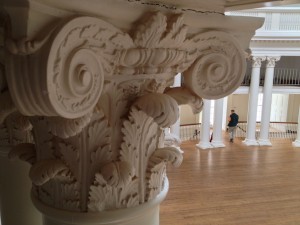
I got a special behind-the-scenes tour of the Rotunda on Saturday. The Rotunda, Jefferson’s library and the centerpiece of his Academical Village, just got done with a roof replacement and now enters the second, more extensive phase of its renovations as they redo the mechanical systems and get ready to return it to a building more integrated with student life. The guide said that they were inspired by the way students took to the McGregor Room in Alderman when it was turned into study space after Special Collections moved into its new dedicated building, and hope to recreate that effect in the oval room across from the Board of Visitors meeting room on the second floor. I can’t think of anything better.
The tour itself was fascinating. We stood in the lower oval rooms on the ground floor and learned what they’ve reconstructed about the larger role of the chemistry labs in the earliest days of the university, when the Rotunda was not just library but also science classroom. We marveled at the graffiti left by builders in the portland cement lining the cistern buried in the east courtyard, long hidden under a fountain. And we got to ascend both tiers of balcony above the Dome Room floor, which have long been off limits to regular tours.
The last part was the most special. Behind an opened panel on the north wall was a small chamber housing the machinery for the north clock. There was a 1970s era unfinished wood structure around the clock mechanism. And the wood structure was covered by signatures of probationary classes of the University Guide Service. The Guides’ secret hideaway had long been a legend, and seeing it in broad daylight was surprising at first. But as I wrote to a friend, I felt that the Guides found a way to become part of the historic fabric of the building in an intimately familiar and ultimately respectful way, just like the builders who left their names in the cement of the cistern. Seeing the signatures meant that my friends had found a way to become a deep part of the history of the University.
Check the Flickr photoset for more.
